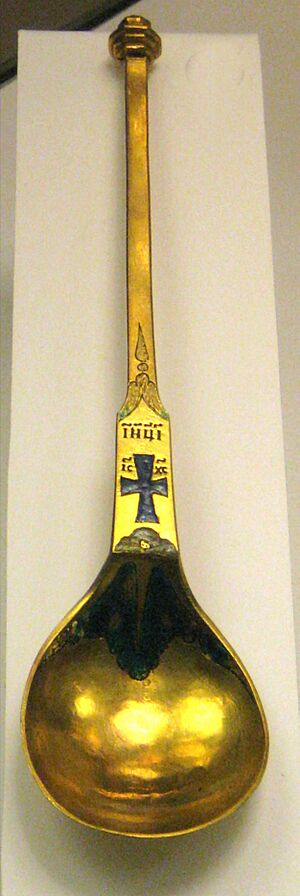Spoon (liturgy) facts for kids
The Spoon (Greek: Κοχλιάριον, Kochliárion; Slavonic: Лжица, Lzhítza) is a special tool used in church services. It helps give out Holy Communion to regular church members during the main church service in some Eastern Christian churches.
It's also called a cochlear, which is Latin for "spoon". In Western Christianity (like in Anglican, Lutheran, and Methodist churches), a spoon with holes is sometimes used. This spoon helps remove any small bits that might fall into the wine. It's one of the items found on a special table called the credence table in Western Christian Churches.
Contents
Why Use the Spoon?
In the Early Church, everyone, including church leaders and regular members, received Holy Communion in the same way. They would take the special bread (the Body of Christ) in their hands and then eat it. They would also drink directly from the chalice (a special cup) with the special wine (the Blood of Christ).
Over time, people became worried about crumbs of the special bread falling on the floor or some of the special wine spilling. Because of this, churches started using tongs. With tongs, the bread and wine were mixed together and carefully placed into the mouths of the people receiving communion. By the 9th century, churches began using the Communion spoon for the same reasons. This practice is still used today. However, church leaders still receive communion in the older way, standing at the Holy Table.
How the Spoon is Used
In the Byzantine Rite
In the Byzantine Rite, when it's time for people to receive Communion, the special bread (called the Lamb) is cut into smaller pieces. This is done with a small knife called the Spear. The pieces are then placed into the Chalice (the special cup). The Spoon is then used to give these pieces, mixed with the wine, to the church members. This way, people receive both the special bread and wine without touching them with their hands.
At the end of the service, a church helper called a Deacon uses the Spoon to finish any remaining special bread and wine. Then, the Spoon, Spear, and Chalice are cleaned using wine and hot water. The special plate (called the Diskos or Paten) is usually cleaned only with hot water.
The Spoon is a holy object, so it's usually kept on a special table called the Table of Oblation (Prothesis). This is where the bread and wine are prepared for Communion. Often, when a Chalice and Diskos are made, a star-shaped cover (called an Asterisk), a Spoon, and a Spear are made to match them. Because it touches the special bread and wine, the church spoon should be made of gold or at least covered in gold.
The Spoon is also used to prepare special gifts (called the Presanctified Gifts) during Great Lent. It's also used for special communion kept for later (called Reserved Mysteries) on Holy Thursday during Holy Week. The priest holds the special bread in one hand over the Chalice. With the Spoon in his other hand, he pours some of the special wine onto the underside of the bread. This is where a cross was cut into the bread earlier during a preparation service.
Since the Spoon is a holy object, it can only be used for church services. No one of a lower rank than a deacon should touch it.
In the Alexandrian Rite
After the priest places a piece of the special bread into a person's mouth by hand, a deacon gives the person the special wine using the Spoon.
In the Maronite Rite
The Maronite Catholic Church is a bit different. In this church, people receive communion by dipping a piece of the special bread into the chalice. A deacon usually holds the chalice. Then, the bread, which has been dipped in the wine, is placed into the person's mouth by hand. The Spoon is often still found with the other church items on the altar, but it's not usually used for communion. This is also true for the Melkite Greek Catholic Church.


